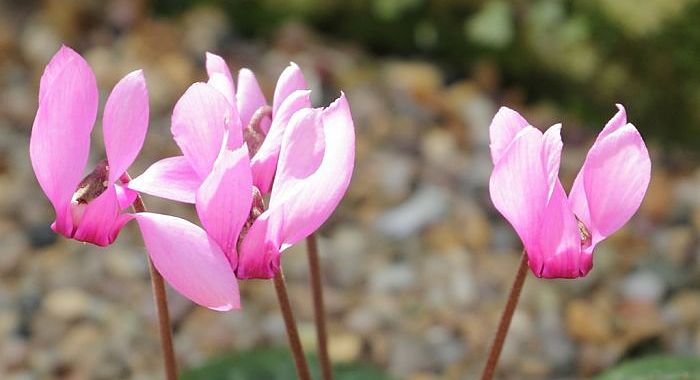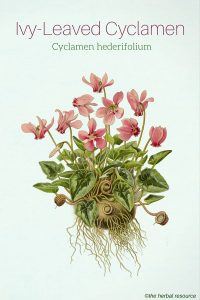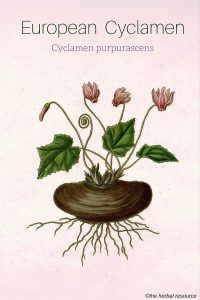Botanical Name: Cyclamen hederifolium, C. purpurascens.
The plant genus Cyclamen contains 19 plant species commonly found in Europe, Mediterranean, Asia and in East Africa.
Persian cyclamen (C. persicum) is a popular houseplant that many people are acquainted with. It often blooms at Christmas time and comes in a variety of cultivars.
It is mainly two spices of cyclamen that have been used as herbal medicine, ivy-leaved cyclamen (C. hederifolium) and European or purple cyclamen (C. purpurascens).
Other Common Names: Ivy-leaved cyclamen, sowbread, spring sowbread, stag truffle, alpefiol (Norwegian), cyclamen à feuilles de lierre (French), Neapolitanisches Zyklamen (German), höstcyklamen (Swedish), vedbendbladet alpeviol (Danish).
Habitat: C. purpurascens is widespread in continental Europe, from eastern France, over the Alps to Poland and south to Bosnia and Herzegovina.
The species is also found in mountainous areas of Romania and in western Russia, where it has been introduced.
The plant grows in deciduous and mixed forests in moist, calcareous soils, from 250 to 1300 m.
C. hederifolium is native to the forest and mountain areas in the Mediterranean region from southern France to western Turkey and the Mediterranean islands.
In Northern Europe, the species is cultivated and is now naturalized in many places. The plant grows in forests and thickets, up to 1200 m.
Plant Description: Cyclamen purpurascens is a 10-15 cm tall, perennial plant with an underground, flat tuberous root-stock.
The leaves are evergreen, heart-shaped to oval kidney-shaped, shiny dark green, often with lighter spots on the upper side, and purple hue underneath.
The flowers sit on separate stalks. The flowers, which are formed in the fall, have curved petal lobes and sit individually on long stems. The fragrant flowers are carmine pink with a darker center.
After flowering, the flower stems form into a downward spiral shape allowing the seeds to ripen close to the ground. The sweet and sticky seeds are attractive to ants, which help to spread them.
Cyclamen hederifolium has a rather large tuber which can be 20 cm or more. It resembles C. purpurascens, but the leaves are slightly lobed and pointed not unlike the leaves of ivy, hence the species name hederifolium (hedera = ivy and folium = leaf).
The leaves on the upper side have a pattern consisting of green and gray-green. The flowers are pale pink and appear before or simultaneously with the first leaves.
As with C. purpurascens, the seeds capsules form on downward spiral shaped stems.
Of all the cyclamen spices, C. hederifolium is the one that is best suited to grow outdoors in countries with a temperate climate and it has become naturalized in many areas.
Plant Parts Used: The part of the plant used in herbal medicine is the fleshy rootstock, which is used fresh and harvested when the plant is in bloom.
Juice from the fresh root tubers of C. purpurascens is used to make the homeopathic agent “cyclamen”.
Therapeutic Benefits and Traditional Uses of Cyclamen
Active Ingredient and Substances: The main active ingredients of cyclamen are triterpene saponins (incl. Cyclamin, deglukocyclamin I and deglukocyclamin II).
Application of Cyclamen as Medicinal Herb in the Past
Although cyclamen is currently not used much as a medicinal herb, it is known that it was used quite extensively in the past.
The root of cyclamen has a very powerful effect, and when it was used it had to be done with great care.
Despite the dangerous side effects, cyclamen was once recommended as a remedy for a variety of ailments, including eye diseases, gout, snakebites, tinnitus, menstrual pains and as a powerful laxative.
The herb has also been used against skin rash.
Pliny the Elder (23-79 AD) stated in his writings that the plant was used as poison applied to arrows in ancient Rome.
Pedanius Dioscorides (1st century AD) suggested that the herb could act as a powerful laxative (purgative), as a remedy for poisoning, as skin cleanser agent and to promote a birth. He also mentioned the use of the herb as an aphrodisiac.
Furthermore, Nicholas Culpeper (1616 – 1654), an English botanist and herbalist, disclosed in his writing that cyclamen could be used to accelerate birth, promote expulsion of the afterbirth and to induce menstruation.
When the herb was used as a laxative, the plant juice from the fresh tubers was applied externally, either over the lower abdomen, bladder or rectal area.
Maud Grieve (1858-1941) wrote that when the herb was used externally as a liniment over the lower abdomen, it provoked an acute diarrhea.
Once, an ointment was made from the fresh rhizomes in order to remove intestinal worms in children. It was also rubbed onto the belly area of adults to induce vomiting and applied over the lower abdomen to increase the flow of urine.
Current Uses of Cyclamen
Cyclamen seem to have the ability to clear the airways blocked by mucus buildup and is utilized as a nasal spray containing freeze-dried powder of the root.
The spray is intended to help to drain the nose and sinuses and thus help to alleviate common symptoms of sinusitis.
When the herb is used in this way, it seems that the saponins only work locally and are not absorbed by the body. Apart from the application as a nasal spray, the herb is now only used as an ingredient in a homeopathic remedy known as “cyclamen”.
Other Uses
The highly toxic saponin, also named cyclamin, works even in small doses to paralyze fish, and fishermen in Sicily used the root tubers to stun fish making it easy to catch them by hand.
Dosage and Administration
Cyclamen is a highly poisonous plant that should not be used internally.
Side Effects and Possible Interactions of Cyclamin
The tubers of all the cyclamen species contain the toxic saponin cyclamin.
Symptoms after consuming the root include nausea, vomiting, diarrhea, severe abdominal pain, hemolysis (breakdown of red blood cells), severe perspiration, circulatory disorders, convulsions and finally paralysis of airways resulting in death.
If the plant sap comes in direct contact with skin, it can cause irritation and blistering.
Since the root-stock and tubers taste very bitter and are underground, there have been very few confirmed cases of poisoning in recent years.
As little as 0.2 g of the root-stock (tubers) will cause symptoms of poisoning, while 8 g are considered lethal dose for a healthy adult.
Animals that eat the tubers do usually have blood in their urine, but pigs can eat them without any harm, which is reflected in one of the English names of the plant, “sowbread”
If there is suspicion of cyclamen poisoning it is vital to seek out medicinal attention as soon as possible. Treatment for poisoning may consist of providing medical charcoal and sodium sulfate.
Supporting References
Barker, Julian: The Medicinal Flora of Britain & Northwestern Europe. Kent, Winter Press 2001.
Breverton, Terry: Brevertons Complete Herbal. A book of remarkable plants and their uses. London, Quercus Publishing Plc 2011.
Gruenwald, Joerg, et al.: PDR for Herbal Medicines. Fourth Edition. Montvale, New Jersey, Thomson Healthcare Inc. 2007.
Hensel, Wolfgang: Medicinal Plants of Britain and Europe. London, A&C Black Publishers Ltd. 2008.
Potterton, David (ed.): Culpeper’s Colour Herbal. Berkshire, Foulsham 2007.
Pullaiah, T.: Encyclopedia of World Medicinal Plants. Vol I-V. New Dehli (India), Regency Publications 2006.
Wink, Michael & Ben-Erik van Wyk: Mind-Altering and Poisonous Plants of the World. Portland, Oregon, Timber Press 2008.
Thordur Sturluson
Latest posts by Thordur Sturluson (see all)
- What is the Difference Between Hemp and Marijuana? - June 3, 2019


